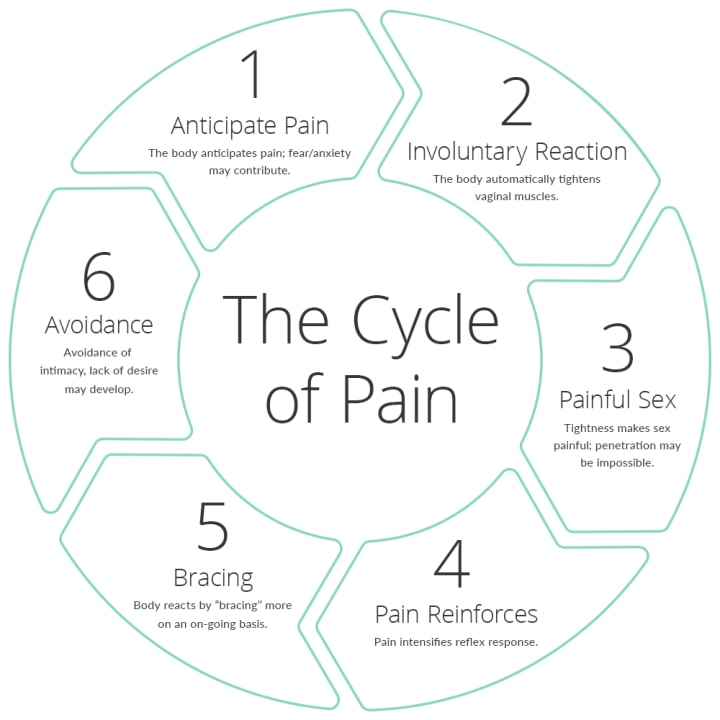Vagi-WHAT?! What Is Vaginismus?
The Cycle of Pain.

Has the word ‘vaginismus’ recently been introduced to your vocabulary?
Vaginismus is a heavy word. For everything it brings, and everything it takes away…
What Is Vaginismus?
Vaginismus is the involuntary spasm of the vagina (contraction of the pelvic floor muscles that tighten the vaginal entrance) that impairs your ability to engage in any form of vaginal penetration, or causes discomfort or pain during such attempts.
Put simply…
It’s when you want to have penetrative sex, or even just wear a tampon, but your vaginal muscles tense up making this practically impossible and very painful.
Some women refer to vaginismus as ‘a panic attack in your vagina’.
It’s like your body, in anticipation of penetration, automatically puts up a wall, not letting anything or anyone inside.
Essentially, your pelvic floor muscles are unable to relax. They become like clam shells that can’t be propped open, unless this is done forcefully (which can come with excruciating pain).

Source: vaginismus.com
It’s important to understand that the muscle tightness occurs without any conscious direction. In other words, you did not consciously make your body tighten, and you cannot simply make it stop. Although your brain may be telling your vaginal muscles to relax and open up, the body might just not cooperate.
What Causes Vaginismus?
There’s no single cause of this condition.
Most often, vaginismus may happen to you if you have an uneasiness about sexual penetration. This can be developed by a traumatic experience such as sexual assault, or an upbringing which has framed intimacy in a negative light, perhaps as religiously unacceptable.
These circumstances may have created the notion that your vagina is off limits, leading to little, if any, self-exploration or acceptance of your sex organs as natural parts of who you are.
You may also have vaginismus even if you deeply desire to enjoy penetrative sex, and do not consciously associate the act with anxiety or fear. The subconscious plays a significant role in your body’s reaction, and can often go largely unexplained.
Alternatively, you may have had a sexual act that was painful, caused by physical factors like insufficient foreplay or lubrication. This may have created an association of sexual penetration to the feeling of pain.
All of the above, whether consciously or unconsciously, create the anticipation of pain.
This is the fist step in the cycle of pain…
The Cycle of Pain Explained
Think of the cycle as a self-fulfilling prophecy.

Source: vaginismus.com
The anticipation of pain leads to the involuntary reaction, where the body automatically tightens the pelvic floor muscles.
You experience painful sex as a result, where entry may be more difficult or impossible depending upon the severity of this tightened state.
This then creates a reinforcement of pain, because the pain you experienced during the attempt of sex reinforces the reflex response, which intensifies the pain even more.
Next, your body reacts by bracing on an on-going basis, where the muscles tighten at the thought of being intimate.
Finally, avoidance develops, and a lack of desire to be intimate altogether may be created, which strengthens the anticipation of pain and the cycle continues even more strongly.
To summarize…
The anticipation of pain leads to its manifestation and then this reinforcement of pain manifests over and over again as you brace for yet another painful experience.
As the cycle keeps playing itself out, the experience of ongoing pain increases the duration and intensity of your involuntary muscle contractions.
Thus strengthening your pain.
That’s why when vaginismus isn’t dealt with, it often worsens.
Is Vaginismus Common?
This condition is more common than you think! Thousands of women are affected by it.
Since the topic of sexual satisfaction isn’t widely discussed, and many women don’t seek help, it is unknown what percentage of women actually suffer from vaginismus.
It is tough to talk about it, isn’t it? That’s because vaginismus can make you feel confused, embarrassed, guilty, and like you’re sexually broken…
Like you’re not good enough.
Understandably, it is extremely frustrating to be unable to physically engage in pleasurable sexual intercourse. These feelings may discourage you from talking about vaginismus, and precisely this avoidance of the topic strengthens your anticipation of pain, which further reinforces the cycle of pain…
That’s why it’s best to face the issue head on, and deal with it sooner rather than later.
Women have been able to beat vaginismus, creating for themselves a lifetime of unconstrained pleasure. You can too!
How Can You Overcome Vaginismus?
The key to overcoming vaginismus is to break the cycle of pain.
This ultimately means to retrain your vaginal muscles, so that in anticipation of intercourse, they are able to relax. To do this, you must learn to take conscious control of these muscles to stop their tightening reflex.
The approach to gain conscious control includes pelvic floor control exercises and dilation training, as well as exercises designed to help you identify and resolve any contributing emotional components.
A holistic approach is often necessary—getting acquainted with your physical body, as well as exploring your particular emotional triggers.
Who Can You Turn To?
Generally, women turn to a physician first, and are often referred to a gynaecologist to rule out any other causes of female sexual pain.
Next, a physical therapist specializing in pelvic floor therapy can be consulted to help with pelvic muscle rehabilitation, control, and relaxation. This therapist will often help administer a self-help program of exercises to be done at home.
This self-help program consists of regular pelvic floor control exercises and dilation training performed in private in the comfort of your home.
Also, psychologists, psychiatrists, and sex therapists can be consulted to help deal with any anxiety, or deeply rooted emotional issues that may be contributing to your anticipation of pain.
Throughout the journey, being part of a safe community of women struggling with vaginismus is irreplaceable, so you can benefit from others’ experiences and tips.
You never have to feel alone again. Other women have overcome vaginismus, and you can learn from their successes!
Learning From Other Women's Successes
To help you on your journey, here is a compilation of 11 tips from real women. These can help you learn from their experiences, shortcuts to implement and mistakes to avoid, so you can become pain free and intimate too.
This PDF reveals all 11 tips from real women on how to overcome vaginismus.

Get “11 Tips From Real Women: How They Overcame Vaginismus With More Ease and Less Pain” now.
There’s no better time than now to establish some certainty in your own path to becoming pain free and intimate.
Why? Because you deserve to feel happy and complete again!
– Katrin, with Love
About the Creator
Katrin with Love
What if intercourse no longer meant pain but screamed pleasure? What you felt happy and complete again?
I beat vaginismus and I want to share the recipe to success with you. Go to katrinwithlove.com.






Comments
There are no comments for this story
Be the first to respond and start the conversation.